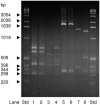Characterization of Neisseria meningitidis isolates from recent outbreaks in Ethiopia and comparison with those recovered during the epidemic of 1988 to 1989
- PMID: 16517868
- PMCID: PMC1393097
- DOI: 10.1128/JCM.44.3.861-871.2006
Characterization of Neisseria meningitidis isolates from recent outbreaks in Ethiopia and comparison with those recovered during the epidemic of 1988 to 1989
Abstract
The objectives of this study were to collect and characterize epidemic meningococcal isolates from Ethiopia from 2002 to 2003 and to compare them to 21 strains recovered during the previous large epidemic of 1988 to 1989. Ninety-five patients in all age groups with clinical signs of meningitis and a turbid cerebrospinal fluid (CSF) sample were included in the study of isolates from 2002 to 2003. Seventy-one patients (74.7%) were confirmed as having Neisseria meningitidis either by culture (n = 40) or by porA PCR (n = 31) of their CSF. The overall case fatality rate (CFR) was 11.6%; the N. meningitidis-specific CFR was 4.2%. All 40 strains were fully susceptible to all antibiotics tested except sulfonamide, were serotyped as A:4/21:P1.20,9, and belonged to sequence type 7 (ST-7). The strains from 1988 to 1989 were also equally susceptible and were characterized as A:4/21:P1.20,9, but they belonged to ST-5. Antigenic characterization of the strains revealed differences in the repertoire of lipooligosaccharides and Opa proteins between the old and the recent strains. PCR analysis of the nine lgt genes revealed the presence of the lgtAHFG genes in both old and recent strains; lgtB was present in only some of the strains, but no correlation with sequence type was observed. Further analysis showed that in addition to their pgm alleles, the Ethiopian ST-5 and ST-7 strains also differed in their tbpB, opa, fetA, and lgtA genes. The occurrence of new antigenic structures in strains sharing the same serogroup, PorA, and PorB may help explain the replacement of ST-5 by ST-7 in the African meningitis belt.
Figures





Similar articles
-
Lack of antigenic diversification of major outer membrane proteins during clonal waves of Neisseria meningitidis serogroup A colonization and disease.Pathog Dis. 2013 Feb;67(1):4-10. doi: 10.1111/2049-632X.12000. Epub 2012 Nov 28. Pathog Dis. 2013. PMID: 23620114
-
Genetic and Antigenic Diversity of Neisseria meningitidis Serogroup B Strains in Vietnam.Pathogens. 2025 May 15;14(5):487. doi: 10.3390/pathogens14050487. Pathogens. 2025. PMID: 40430807 Free PMC article.
-
A New Sequence Type of Neisseria meningitidis Serogroup C Associated With a 2016 Meningitis Outbreak in Mali.J Infect Dis. 2019 Oct 31;220(220 Suppl 4):S190-S197. doi: 10.1093/infdis/jiz272. J Infect Dis. 2019. PMID: 31671437
-
Meningococcal serogroup W135 in the African meningitis belt: epidemiology, immunity and vaccines.Expert Rev Vaccines. 2006 Jun;5(3):319-36. doi: 10.1586/14760584.5.3.319. Expert Rev Vaccines. 2006. PMID: 16827617 Review.
-
Recent outbreak of meningococcal meningitis--a microbiological study with brief review of literature.J Commun Dis. 2007 Dec;39(4):209-16. J Commun Dis. 2007. PMID: 18697589 Review.
Cited by
-
Bioengineered polyester beads co-displaying protein and carbohydrate-based antigens induce protective immunity against bacterial infection.Sci Rep. 2018 Jan 30;8(1):1888. doi: 10.1038/s41598-018-20205-7. Sci Rep. 2018. PMID: 29382864 Free PMC article.
-
Specificity of subcapsular antibody responses in Ethiopian patients following disease caused by serogroup A meningococci.Clin Vaccine Immunol. 2008 May;15(5):863-71. doi: 10.1128/CVI.00252-07. Epub 2008 Mar 12. Clin Vaccine Immunol. 2008. PMID: 18337382 Free PMC article.
-
Awareness of meningococcal disease among travelers from the United Kingdom to the meningitis belt in Africa.Am J Trop Med Hyg. 2014 Aug;91(2):281-6. doi: 10.4269/ajtmh.13-0763. Epub 2014 Jun 2. Am J Trop Med Hyg. 2014. PMID: 24891461 Free PMC article.
-
Metabolic shift in the emergence of hyperinvasive pandemic meningococcal lineages.Sci Rep. 2017 Jan 23;7:41126. doi: 10.1038/srep41126. Sci Rep. 2017. PMID: 28112239 Free PMC article.
-
Measurement of functional anti-meningococcal serogroup a activity using strain 3125 as the target strain for serum bactericidal assay.Clin Vaccine Immunol. 2011 Jul;18(7):1108-17. doi: 10.1128/CVI.00549-10. Epub 2011 May 18. Clin Vaccine Immunol. 2011. PMID: 21593240 Free PMC article.
References
-
- Achtman, M., B. Kusecek, G. Morelli, K. Eickmann, J. F. Wang, B. Crowe, R. A. Wall, M. Hassan-King, P. S. Moore, and W. Zollinger. 1992. A comparison of the variable antigens expressed by clone IV-1 and subgroup III of Neisseria meningitidis serogroup A. J. Infect. Dis. 165:53-68. - PubMed
-
- Ajello, G. W., J. C. Feeley, P. S. Hayes, A. L. Reingold, G. Bolan, C. V. Broome, and C. J. Phillips. 1984. Trans-Isolate medium: a new medium for primary culturing and transport of Neisseria meningitidis, Streptococcus pneumoniae, and Haemophilus influenzae. J. Clin. Microbiol. 20:55-58. - PMC - PubMed
-
- Bernardini, G., G. Renzone, M. Comanducci, R. Mini, S. Arena, C. D'Ambrosio, S. Bambini, L. Trabalzini, G. Grandi, P. Martelli, M. Achtman, A. Scaloni, G. Ratti, and A. Santucci. 2004. Proteome analysis of Neisseria meningitidis serogroup A. Proteomics 4:2893-2926. - PubMed
-
- Berrington, A. W., Y. C. Tan, Y. Srikhanta, B. Kuipers, P. van der Ley, I. R. Peak, and M. P. Jennings. 2002. Phase variation in meningococcal lipooligosaccharide biosynthesis genes. FEMS Immunol. Med. Microbiol. 34:267-275. - PubMed
Publication types
MeSH terms
Substances
Associated data
- Actions
- Actions
- Actions
- Actions
LinkOut - more resources
Full Text Sources

